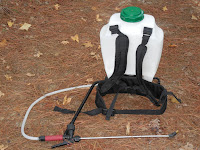Over the years, Kate and I have developed a nice network of logging roads, firebreaks and footpaths through our own property (you can read more about them here). Over time I've discovered the tools that make maintenance much easier.
I should note that I don't have an all-terrain vehicle (although I want one badly!), so any tool I use has to be transported on foot. Thus, having tools that are compact and lightweight is a top priority. Your selection can be adjusted based on your size, strength and endurance, and/or your access to a powered conveyance.
A good backpack sprayer is vital. Mine holds four gallons and has padded straps. I strongly recommend getting one with both a hip belt and sternum strap.
A 15-gallon sprayer mounted on an all-terrain vehicle would be nice. However, using handheld equipment allows me to make very targeted applications. I therefore use less product and can avoid spraying desirable plants such as wildflowers and these pretty ferns.
Pruning tools also come in handy. I routinely trim side and overhead branches and vines that are beginning to encroach upon the trail. A quality pair of hand pruners is vital. I also frequently use a folding pruning saw that fits in my pocket.
On rare occasions I will use this sling blade when I don't want to take the time to mix up herbicide (or have run out). It's fine for quick touch up of weedy/grassy areas, but I couldn't use it for long stretches. A gas powered string trimmer is also useful at times.
OK, I admit sometimes I have to pull out the big guns. A four-wheel drive compact utility tractor with front end loader and box blade does come in rather handy when you really need to move some dirt.
Lastly, there is no substitute for hiking boots. Walking on the trails on a regular basis helps to compact the soil and make it harder for weed seeds to germinate and plants to take root.
 |
| Walking the trails compacts the soil. I have a second boot just like this one for the other foot. |








No comments:
Post a Comment